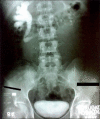Laparoscopic transperitoneal pyelopyelostomy and ureteroureterostomy of retrocaval ureter: Report of two cases and review of the literature
- PMID: 20814513
- PMCID: PMC2924550
- DOI: 10.4103/0972-9941.65166
Laparoscopic transperitoneal pyelopyelostomy and ureteroureterostomy of retrocaval ureter: Report of two cases and review of the literature
Abstract
We report two cases of retrocaval ureter that were successfully treated by a laparoscopic transperitoneal approach. Presentation of both these cases was with flank pain. Ureteroureterostomy using an intracorporeal suture technique was performed for one, and pyelopyelostomy for the other case. Operative time was 120 min and 110 min, respectively. Pyelopyelostomy was technically easier to perform than ureteroureterostomy that required an extra fourth port insertion to facilitate dissection. With increasing experience with the intracorporeal suturing laparoscopic technique of either pyelopyelostomy or ureteroureterostomy should be the first choice for retrocaval ureter.
Keywords: Retrocaval ureter; laparoscopy; pyelopyelostomy; ureteroureterostomy.
Conflict of interest statement
Figures



References
-
- Simforoosh N, Nouri-Mahdavi K, Tabibi A. Laparoscopic pyelopyelostomy for retrocaval ureter without excision of the retrocaval segment: First report of six cases. J Urol. 2006;175:2166–9. - PubMed
-
- Tobias-Machado M, Lasmar MT, Wroclawski ER. Retroperitoneoscopic surgery with extracorporeal ureteroureteral anastomosis for treating retrocaval ureter. Int Braz J Urol. 2005;31:147–50. - PubMed
-
- Chung BI, Gill IS. Laparoscopic Dismembered Pyeloplasty of a Retrocaval Ureter: Case Report and Review of the Literature. Eur Urol. 2008;54:1433–6. - PubMed
-
- Ouyang CC, Chueh SC, Hsu TC, Chen J, Tsai TC, Chiu TY. Retrocaval ureter- three case reports and review of the literature. J Urol ROC. 1994;5:49–53.
-
- Baba S, Oya M, Miyahara M, Deguchi N, Tazaki H. Laparoscopic surgical correction of circumcaval ureter. Urology. 1994;44:122–6. - PubMed
Publication types
LinkOut - more resources
Full Text Sources
